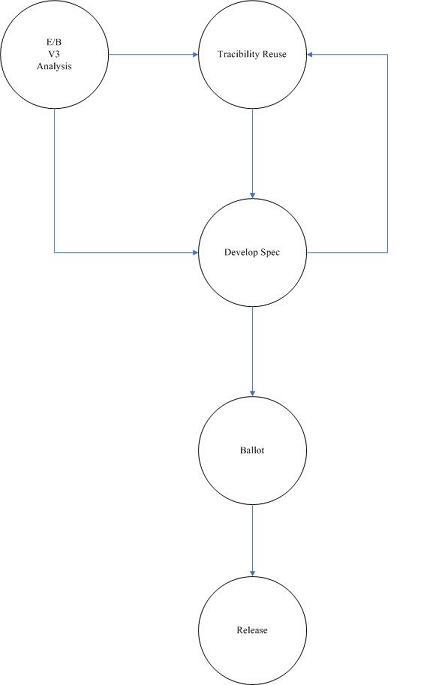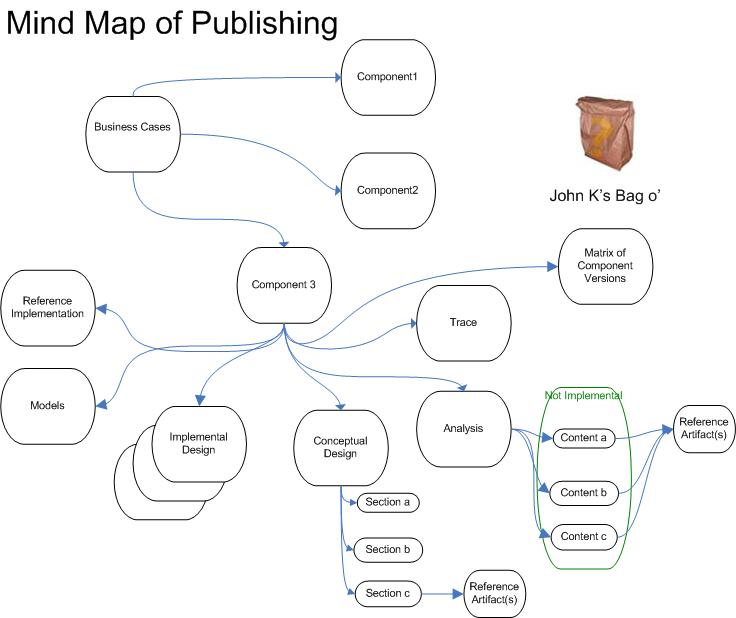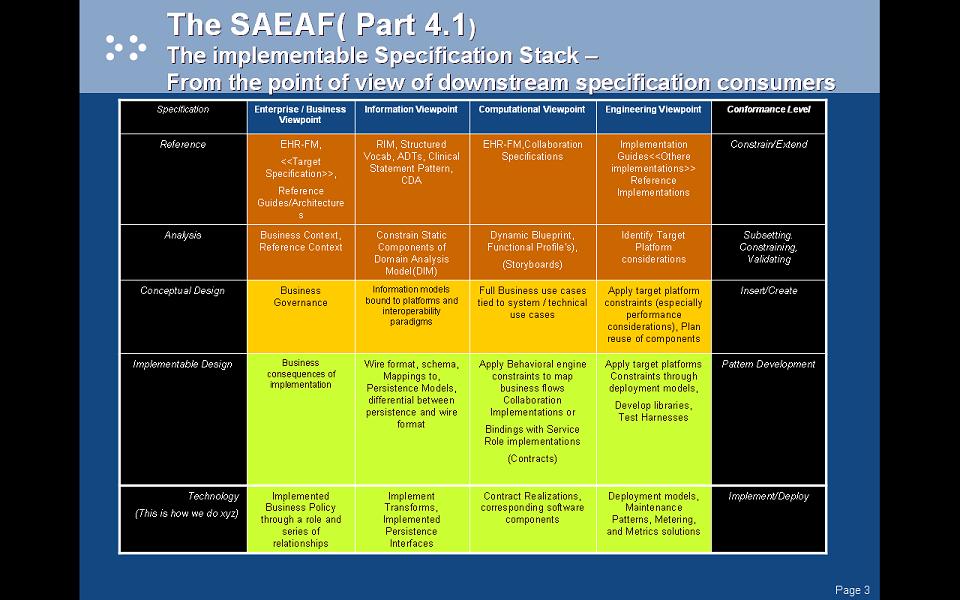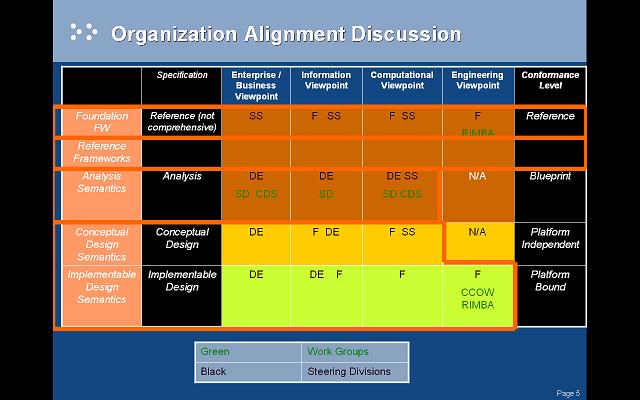20081113 ArB Out of cycle
Architecture Board
November 13, 2008
Contents
Attendees
| Name | With | Present | Organization | ||
| Beeler, Woody | Guest | No | Beeler Consulting | woody@beelers.com | |
| Connor, Kathleen | Guest | No | Microsoft | Kathleen.connor@microsoft.com | |
| Curry, Jane | ArB | Yes | Health Information Strategies | janecurry@healthinfostrategies.com | |
| Duteau, Jean-Henri | Guest | No | HL7 Canada | jean.duteau@gpinformatics.com | |
| Grieve, Grahame | ArB | ? | Kestral Computing | grahame@kestral.com.au | |
| Julian, Tony | ArB | Yes | Mayo Clinic | ajulian@mayo.edu | |
| Klein, Ted | Guest | No | Klein Consulting, Inc | kci@tklein.com | |
| Koisch, John | ArB | Yes | NCI | koisch_john@bah.com | |
| Kriesler, Austin | Guest | No | SAIC | duz1@cdc.gov | |
| Larsen, Ed | Guest | Yes | HITSP | e.larsen@ix.netcom.com | |
| Loyd, Patrick | Guest | Yes | GPI | patrick.loyd@gpinformatics.com | |
| Lynch, Cecil | ArB | Yes | ontoreason LLC | clynch@ontoreason.com | |
| McKenzie, Lloyd | Guest | Yes | HL7 Canada | lloyd@mckenzie.com | |
| Mead, Charlie | ArB | Yes | Booz Allen Hamilton | charlie.mead@booz.com | |
| Mulrooney, Galen | Guest | Yes | VHA | galen.mulrooney@va.gov | |
| Ocasio, Wendell | Guest | Yes | DOD/MHS | wendell.ocasio@agilex.com | |
| Orvis, Nancy | ArB | ? | DOD | nancy.orvis@tma.osd.mil | |
| Parker, Craig | Guest | No | ASU | craigparkermd@gmail.com | |
| Parker, Ron | ArB | Yes | CA Infoway | rparker@eastlink.ca | |
| Quinn, John | ArB | Yes | Health Level Seven, Inc. | jquinn@HL7.org | |
| Shakir, Abdul-Malik | ArB | Yes | Shakir Consulting | ShakirConsulting@cs.com | |
| VanHyenteryck, Karen | Guest | No | HL7 | karenvan@hl7.org | |
| Walker, Mead | ArB | Yes | Health Data and Interoperability | dmead@comcast.net | |
| Yongjian, Bao | ArB | No | GE Healthcare | yongjian.bao@med.ge.com | |
| Bear, Yogi(template) | Guest | No | US Dept. Interior, National Park Service | yogi@jellystonepark.gov |
8:00 Welcome
The meeting was called to order at 8:15am U.S. EST by John Koisch with Tony Julian as scribe.
Approval of Agenda
The following agenda was approved:
- 0800 - 0830 -- Welcome, Approval of Agenda, Review of Wednesday's Meeting
- Welcome
- Approval of Agenda
- Review of November 12 meeting
- SAEAF Collaborative Governance with other SDOs
- Discuss HITSP and NHIN
- OHT
- ??0830 - 1000 -- SAEAF Comment Dispositions and Revisions
- 1000 - 1015 -- Break
- 1015 - 1130 -- The Timeline for Implementation of the SAEAF
- 1130 - 1230 -- Communication Plan
- Education items and the SAEAF
- Discuss times for the December Co-chair call and plan
- Including the December Co-Chair Conference Calls and the January Free Education Session
- 1230 - 1330 -- Lunch
- 1330 - 1500 -- Review of past topics OR Conformance Testing and the SAEAF (cont'd)
- 1500 - 1530 -- Break
- 1530 - 1700 -- Review of past topics OR Impact Compilation, Next Steps, Review
- HSSP Service Specification
8:30 SAEAF Internal Governance
Lloyd McKenzie: DAM is not reference.
John Koisch: DAM IS reference.
Jane Curry: End product has to be executable specification? All other are subset?
Lloyd McKenzie: Domain is part of the reference.
Jane Curry: EHR-functional profile is in analysis.
John Koisch: Domain specific belongs in analysis.
Lloyd McKenzie:Within EHR-FM they are creating a reference artifact for other groups. Reference is external upon which you will base your analysis.
John Koisch: EHR-FM is a reference artifact for most groups.
Ron Parker: The group creating an artifact creates an artifact which is reference for others.
John Koisch: SAEAF is reference artifact for everyone except ArB.
Abdul-Malik Shakir:: Placement of artifacts is workgroup specific?
Cecil Lynch: We need a column called context.
John Koisch: What Jane said is that you can use anything and squeeze it down to provide traceability. You can build your DAbdul-Malik Shakir:, RIMS, whatever, what brings it down to concrete is the determination of what is needed for this business case.
Jane Curry: I would like to see a matrix looking at it from the bottom up - at implementation stage, what are the artifacts and who is responsible, and where is the traceability.
John Koisch: From the HL7 perspective this is part of the governance.
Jane Curry: Producer is workspace, for others it is reference. Take the business viewpoint all the way down, at Implementation stage they have to state all of the items in the conceptual and analysis, and they have to be able to sign up to that. You dont have a service until it is stated.
John Koisch: All of this is in the engineering viewpoint/implementable design.
Ed Larsen:THere are two things I am having trouble with:
- The viewpoints of RM-ODP do have a relationship, even if they are independent.
- The use of analysis: one is requirements analysis, but I would see it as conceptual design.
John Koisch: Lets spend some time re-building the grid. We have to be able to produce a series of impact statements for other work groups.
Jane Curry: The impact is other HL7 WGs.
John Koisch: The end-stage is governance, when WGs and other SDOs are making this implementable, that is enacted governance. We have to come up with a timeline and statements of impact.
Jane Curry:N/A in implementable design is wrong.
John Koisch: Conformace at any lower level assumes conformance at the level(s) above it.
Jane Curry:We must collaberate at the Impl/Design level.
John Koisch:You might make a statement here that if you are going to do this, do it this way . . .
Jane Curry: We were concentrating on inside the automation boundary, and have assumptions on what is outside the boundary, that somewhere need to be articulated. When you get it down to a service role there must be instructions. We need to look at it from the bottom up. What HL7 has not expressed is the criteria an implementor needs.
John Koisch:XML flavored V3 is so hard.
Ron Parker:This is a business oriented look using XML.
Further documentation will captured in the slide
The SAEAF( Part 4.1) The implementable Specification Stack - From the point of view of downstream specification consumers
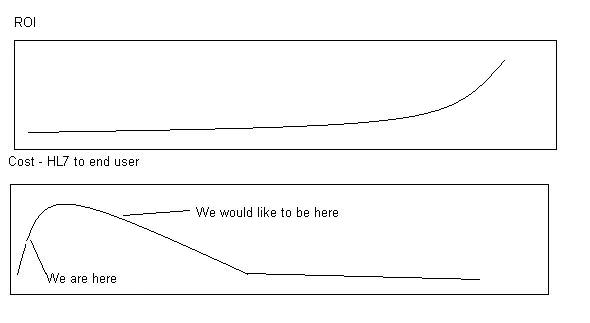
10:00 Break
10:30 SAEAF Internal Governance (Cont)
Discussions continued polishing the SAEAF Executive Overview deck.
Diagram SAEAF (Part 4)
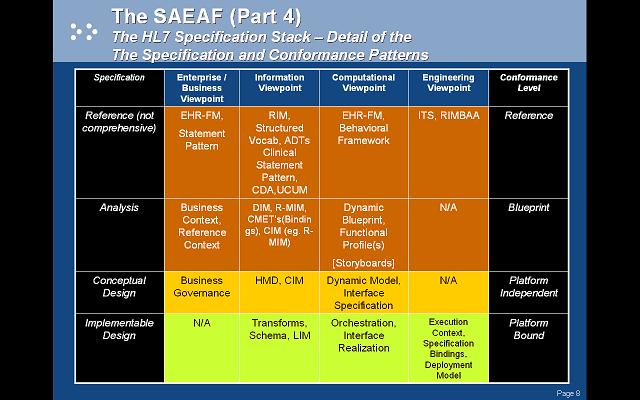
Jane Curry:STRUCDOC is doing CDA R3.
John Koisch:They are confusing the CDA functional profiles with CDA.
Ron Parker:Where does it land?
Jane Curry:What happens to the legacy ?
John Koisch: The HL7 Development diagram:
Mead Walker:There would be a common definition based in the RIM.
Ron Parker:These RIM conformant thingies are harmonized RIM contact. The value proposition of participating in HL7 has to come back to some form of reference model.
Jane Curry:The specifications we produce are at the reference level, or derived from clinical/domain groups bringing the need, and formulating the specifications to meet the requirements.
John Koisch:RIM and CDA are frameworks, that get cobbled together to meet a business purpose. HL7 produces frameworks, implementable things, or HL7 builds business stuff.
Mead Walker:As long as we dont allow people to use other information models. We only have one framework for information model.
John Koisch:The business stuff is incorporated in the Conceptual Design and the Implementable Design. Harmonization is that new requirements are being applied to the framework.
Jane Curry:Either actual use exposes missing or incorrect pieces that you need to add clarity or fill in the gap. Actual use also identifies unused components that need to be withdrawn.
John Koisch:The other bit on this slide is that to build the Conceptual Design and Implementable Design you need cross-functional teAbdul-Malik Shakir: in the analysis and reference spaces.
JK draws on pad: Two Lines of Business
- Application of Reference Frameworks
May include development of Reference Frameworks. A double swim lane of RM-ODP viewpoints.
Function of Arb (structure) , MnM (execution)

- Build, borrow, or align
- "The business of Healthcare/Life Sciences/Regulatory Monitoring"
12:30 Lunch
13:40 Review of past topics OR Conformance Testing and the SAEAF (cont'd)
Continued refining diagrAbdul-Malik Shakir: for SAEAF
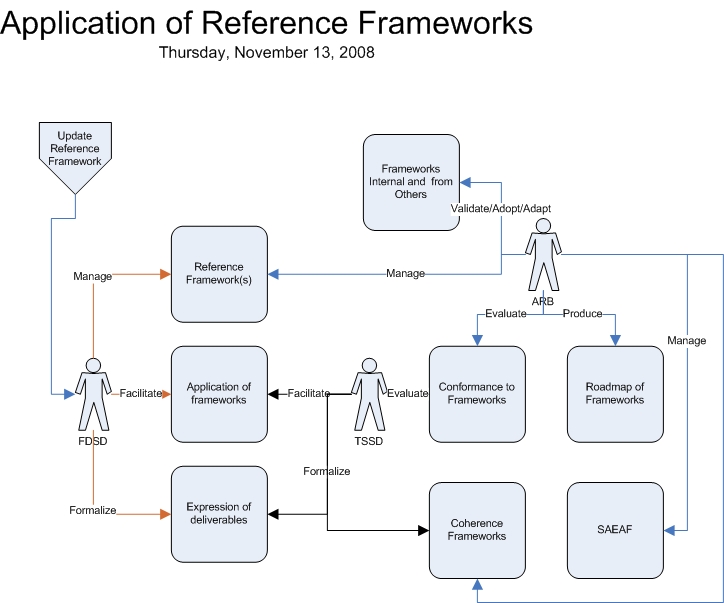
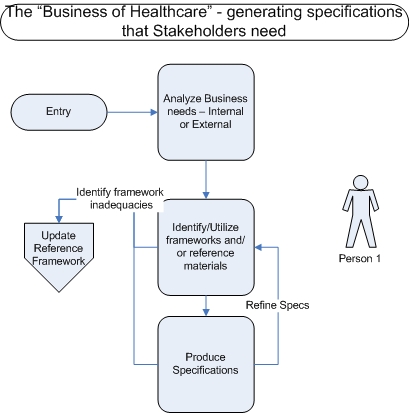
15:00 Break
- Success Criteria
- Cost/Benefit Analysis
- Maturity Model
- Gap Analysis
- Strategy, Tactics, Priorities
- Recommendations and Timelines
16:00 Impacts
- Some
- Templates, Models, Pattern
- Including project management documents
- Checklist of artifacts?
- Methodology for WG
- RPF/EPF for modeling (can be extracted)
- HDF needs to align with SAEAF
- Refinement at the requirements level
- Stronger than "recommended best practice"
- Refinement of "produce specification" step
- Decomposed and some replaced
- SAEAF needs to be evolved along themes
- Conformance/Compliance
- 4 types of Governance
- Constaint patterns expressed
- Information
- vocab
- Transition to new formalisms
- Business
- computation
- Information
ballot publication
- Fold BF into SAEAF - or pull it out
- Education
- Tooling
- Organizational Implications
- Need for dedicated support to early implementors
- 1-3 alpha projects
- Criteria
- Crosses two or more WorkGroups but less than 15
- Not already under way - initiated but not started (in inception phase)
- Crisply defined scope - no fuzzyness
- Dedicated resources
- Not about the foundational or structural
- Meets a fully functional requirement
- ISRS or behavioral specification
- End-to-End business case with implementers ready to do it
- Hit as much of the SAEAF framework as possible.
- Could be a subcomponent of Mind map of Publishing
This is hard
Oh shit!!!
- Mind Map of Publishing
- Business cases define relationships to or use of HL7 components
- These components reference other components such as
- Reference Implementation
- Models
- Implementable design
- Conceptual Design
- Analysis
- Trace
- Matrix of component versions
- Reference to items that are components
- Content a
- Reference other artifacts
- Content b
- Reference other artifacts
- Content c
- Reference other artifacts
- Content a
- Which reference other components
Parking Lot
- What is the dependency matrix of a spec? Regisry of implemented HL7 specs with version numbers
ACTION ITEM: what is the minimum requirements to publish?
ACTION ITEM: Require that implementations register. If you dont register, we dont know to contact you if something changes. Compliance certification (?) requires version.
Organization discussion
The intent of this slide is an exercise in looking at the SAEAF stack from the viewpoint of the implementor. No other inference should be made.
The purpose of this slide is to attempt to classify the current organization by the output. No other inference should be made.
The purpose of this slide is to attempt to clarify the organization by the types of output. No other inference should be made.
17:00 Adjournment
The meeting was adjourned at 18:00 U.S. EDT.Tony Julian
